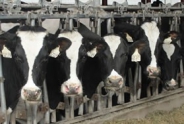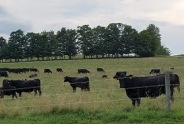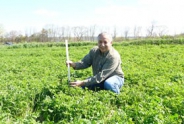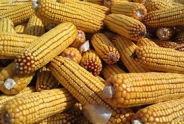Feeding High Forage Diets Successfully
David Balbian, Area Dairy Specialist
Central New York Dairy and Field Crops
Let's start out with a definition. What is a high forage diet? Some people will say 60% forage (on a dry matter basis) would be high forage. Others would say it needs to be 70% to be considered high forage. You can decide that for yourself.
Next we need to decide what a forage is. Certainly pasture, dry hay, haylage, or baleage would be considered forages. But what about corn silage? Corn silage is often described as being made up of 50% grain and 50% stover on a dry matter basis. So, is it really all forage? Again, that is up to the person making the determination. Sometimes people will "high chop" their corn silage. That concentrates the grain, so now the corn silage might be 60 to 65% grain. Is it still a forage? And how about Snaplage? This is where the chopper snaps off the ear. The product can vary anywhere from nearly being ground ear corn to everything on the corn plant from the ear on up. Should that be considered 100% grain or should it be considered part forage? Feedstuffs such as Wet Brewers Grain are sometimes fed and utilized as a forage extender. It is made up of spent grains left over from the beer making process. The starches & sugars are mostly gone from the barley (& sometimes rice & other grains) and can include some leftover hops. It's typically very wet, high in protein (comes from the germ portion of the grain), and high in digestible fiber. When incorporated into a dairy diet, wet brewer's grain (on a dry matter basis) will typically displace equal parts of forage and grain. So, it could be considered 50% grain and 50% forage.
There is much confusion on all of these issues when it comes to calculating what percent forage you may have in your diet(s). The bottom line for most producers is how to feed lots of forage to minimize how much grain they will need to buy and how much cash they will need to spend on that purchased grain, all without sacrificing milk production.
For producers who pasture their cows, a well-planned out and well managed intensive grazing system will produce high quality forage that is hard to beat. And, it will likely be very cost competitive. There are bounds of resources available describing how to set up and manage these systems. There are entire books available. However, forage from a grazing system is not available year around in our part of the country. So, even if you have an intensive grazing system in place, you will still need high quality forage during the rest of the year.
Growing and storing high quality forages for your herd does not come without cost. That being said, probably the single most critical factor affecting haycrop forage quality is timeliness of harvest. Every year is different when it comes to the timing of first cut harvest. Some years we have an early spring and sometimes we have a late spring. Every year our haycrop harvest is also competing for your time when you have corn to plant and manure to spread (for those with a manure storage). Having equipment ready and labor lined up ahead of time is critical to getting all of these tasks completed in a timely manner, especially when you consider the limited windows of time that are typically available because of weather delays.
Research at various universities and work in the field has taught us that we can use alfalfa height in the spring to predict when to harvest alfalfa, grass, & mixed stands to achieve the kind of quality needed to feed high forage diets to our lactating cows. Every spring our Cooperative Extension team measures alfalfa height weekly on 60 or so fields across the eight counties we cover. Data is plugged into an excel spreadsheet that is set up to predict harvest dates that will provide high quality forage for lactating cows. Results are emailed out to our team email list. Information for each field includes County, Township, Road Name, Elevation, Alfalfa Height, Predicted Grass % NDF, Predicted 50/50 Mix % NDF, Predicted Alfalfa % NDF, Predicted Date to Cut Grass, Predicted Date to Cut Mix, and Predicted Date to Cut Alfalfa. Most people can find a field that mimics their fields. This email list grows every year and has proven itself to be a valuable tool for dairy producers and their advisors. To be placed on the list simply email your email address to herkimer@cornell.edu with the words "ADD TO FIRST CUT FORAGE QUALITY LIST" in the subject line.
The vast majority of successful "high forage" diets contain C.S. as the primary forage. There are several reasons for this. A high energy forage with plenty of starch is a good foundation for a high forage diet. When BMR Corn Silage is fed we are also getting high levels of digestible fiber that provides energy. Energy is the primary limiting factor for our high producing dairy cows. Our ability to extract all of the energy out of C.S. has been enhanced by the use of kernel processing. Corn silage's low protein content allows your nutritionist plenty of room to fine tune protein fractions and to easily balance for amino acids without suffering an energy penalty that excreting excess protein can cause, such as can be the case with large amounts of 25% crude protein haylage in the diet. The haycrop portion of these high forage diets is typically high quality alfalfa, an alfalfa/grass mix, or straight grass. They key for any of them is that quality must be high along with excellent fermentation.
Excellent day-to-day feeding management is critical for high forage diets to work well. You're depending on the forage portion of the diet for more of the nutrients the cow is receiving. You'll need to have an adequate inventory of consistently high quality highly digestible forage to make high forage diets work. The feeder needs to be "proactive" when it comes to staying on top of forage dry matter changes, cow number changes, and weather effects that could impact dry matter intake. One of the worst errors a feeder can make when feeding a high forage diet is allowing the cows to run out of feed.
Other strategies being used to successfully achieve the forage quality needed for a high forage diet include the following:- Harvesting cover crops in the spring for high quality highly digestible forage. Producers with experience doing this have called this feed "rocket fuel." Some are putting it away and feed it during the hot summer period. The high digestibility helps to stimulate dry matter intake during the heat of the summer. You need to weigh the benefits of producing this feed against any yield losses you might have by delaying C.S. planting on your farm.
- Low lignin alfalfa is often touted as holding its feed value longer so that you can delay harvest, improve yields per cutting, and still maintain quality. Some folks are looking at the same cutting schedule they have always used to get the improved fiber digestibility. Work with your crop advisor in weighing the costs vs. benefits on this.
- Meadow Fescue is a more digestible grass than other grass species. With grass quality declining much more rapidly than alfalfa as it ages, this is an option to consider when seeding down with grass alfalfa mixes.
- Planting BMR Corn Silage is a strategy some people are using. There is no doubt that the fiber digestibility can't be beat when compared to other varieties out there. Cost is higher and yields still lag. It's more vulnerable to leaf diseases and has some standability issues. You will feed less grain & cows will eat more of this C.S., so inventory management needs to be considered. Work with your crop adviser & nutritionist to determine the plusses and minuses for your farm.
Let's look at an example:
The forage that is most likely to have dry matter changes is typically haylage. Let's say cows are getting 22 lbs./cow/day as fed of a 40% dry matter haylage. For 100 cows that would come out to 2,200 lbs./day. If the haylage becomes wetter over a week's period of time and is now 30% dry matter, this group of cows should now be getting 2,933 lbs./day. (The 22 lbs. x .40 = 8.8 lbs./dm/cow/day. 8.8 ÷ .30 = 29.33 lbs./cow/day x 100 = 2,933 lbs. to feed per day.) This shortfall will leave the bunks licked clean and daily milk production will likely fall. Being observant to notice this change (even though it occurred over a week's period of time) AND being PROACTIVE by checking the dry matter on the haylage and making adjustments BEFORE the bunk was licked clean would have kept feed intake & bulk tank on an even keel.
- Have fresh feed available to cows right after milking. This could be fresh delivery of feed or feed being pushed up.
- Be sure feed says fresh and is not reheating in the feed bunk. This is especially important during the hot summer months. If this is a problem you may need to add a TMR preservative. This is only a band aide. The long term solution needs to be solved at the bunker silo. Poor stability due to inadequate oxygen exclusion or feed out issues will need to be addressed to solve this.
- Keep feed mangers clean & smooth.
- Push up feed frequently (especially with 1X feeding) so cows always have access to feed & are stimulated to come up to the feed bunk. Limit time without access to feed to a maximum of 2 to 3 hours in a 24 hour period.
- Provide plenty of resting time. Limit holding pen time to no longer than 1 hour per milking.
- Limit overcrowding, especially in 3 or 6 row barns.
- Be sure to provide easy access to fresh clean water.
- Separate 1st calf heifers into their own group if possible. Fresh cows can also benefit from their own group.
- Provide a cow environment with excellent cow comfort. This includes comfortable & properly sized stalls, and excellent ventilation & lighting. Don't forget cow comfort for your dry cows. There is a carryover effect once they calve.
- If you graze, be sure cows have shade & water available. Consider letting cows inside with excellent ventilation during hot sunny days with feed available inside. Give them full access to pasture at night. Some corn silage is an excellent nutritional complement to high quality pasture. It can dilute excess protein from well managed pasture, it has less heat of digestion than hay, baleage, or haylage, and provides a boost of energy when they need it the most (heat of the summer).
The bottom line to success with "high forage" diets is that attention to details in every way is important. You must start out with high quality forage. As a starting point, check the NDF levels (on a dry matter basis) from your forage tests. Your alfalfa should be around 40%. Your grasses should be around 50% NDF and your C.S. should be around 40% with starch being around 35%. This is a starting point. Fiber digestibility is another issue to discuss that we do not have time to review right now. We'll do that at another time. You'll notice that I did not mention protein levels. That's because protein should not be a limiting factor in your rations. High protein forages are economically beneficial and can offset some purchased protein expense, but it should not be a limitation for your nutritionist. It's fiber levels and how digestible that fiber is that really drives forage quality. If you don't have high quality forage, you'll end up shooting yourself in the foot by trying to feed a high forage diet. Milk production will suffer, reproduction will suffer, and your economic bottom line will be worse, not better.
Upcoming Events
2026 Dairy Day
January 13, 2026 : Dairy Day - Hamilton
Hamilton, NY
Lunch included
January 14, 2026 : Dairy Day - Ballston Spa
Ballston Spa, NY
Lunch included
2026 Corn & Soybean Day
January 20, 2026 : Corn & Soybean Day - Hamilton
Hamilton, NY
Lunch included. 2.75 DEC Credits available
January 21, 2026 : Corn & Soybean Day - Ballston Spa
Ballston Spa, NY
Lunch included. 2.75 DEC Credits available
Announcements
Statewide Field Crop Pathology Needs Assessment Survey
Your input is wanted for identifying priorities!Sign Up for Our Weekly E-Newsletter
We send out a bi-weekly e-newsletter that has announcements, upcoming programs, and opportunities for you! Registration is quick, easy, and free. Click here to sign up today!Farmers Can Join MeatSuite For Free!
MeatSuite.com is a free resource provided by Cornell University where NY meat farmers can create a farm profile and list their bulk (wholes, halves, quarters) and bundled (i.e. Grilling Bundle) meat products.Why should farmers join?
1. It's free and easy!
2. Connect with more local customers. In the past year the MeatSuite.com farm directory had 8,300 visits from New York consumers. Farm profiles get as many as 25 views per month from potential local customers. We also spotlight MeatSuite farms on social media and bring attention and purchases to farms through highlights and giveaways.
How do I join?
Farmers can visit https://www.meatsuite.com/farmers/ to create a free farm profile. You must list at least one product for your farm's profile to go live. You'll also have access to Cornell's free Meat Price Calculator, a helpful tool for pricing your meat to make a profit.
While you're on MeatSuite, check out the "Creating Consumer-Friendly Bulk Meats" publication on the log-in page. It has tips on how to create bulk meat products that are easier for first-time buyers to say "yes" to.
If you have any questions as you create your farm profile or products, we're here to help! Please email Matt LeRoux at mnl28@cornell.edu.




